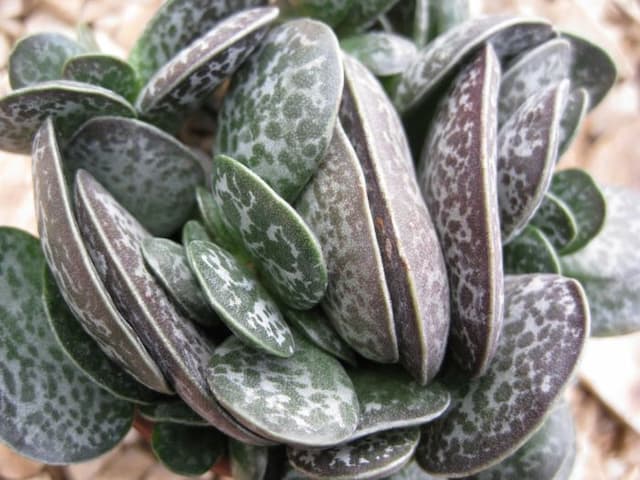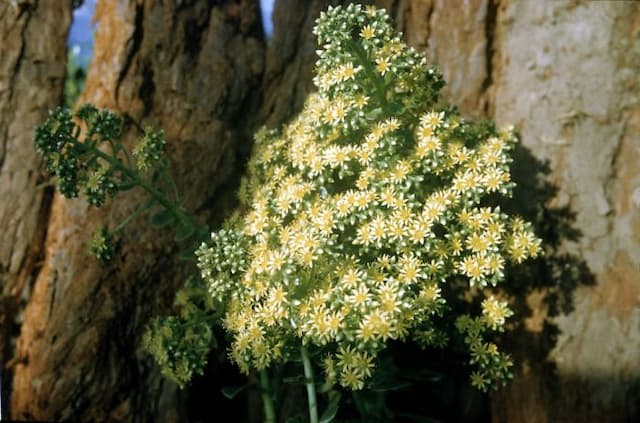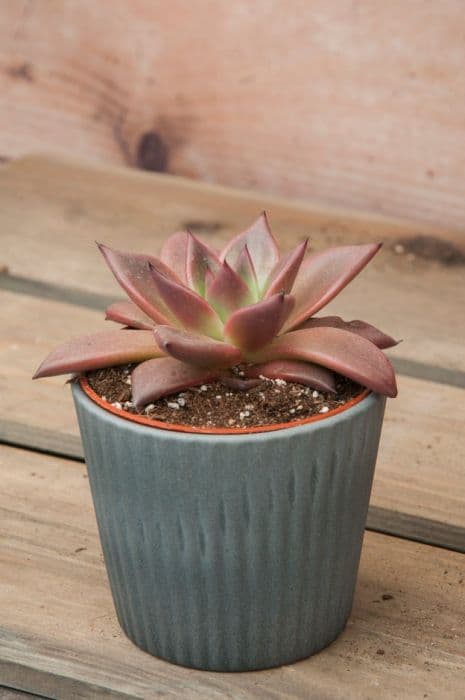Miniature echeveria Echeveria minima



ABOUT
Echeveria minima is a small, evergreen succulent with densely packed leaves. A rosette reaches up to 6 inches, but usually 1 rosette is about 1.5 inches.
The leaves of the plant are grayish green with pink tips. The pink color of the edges of the leaves intensifies with increasing light levels.
Echeveria minima blooms in late spring. The flowers of this miniature succulent are bell-shaped and yellow-pink in color. They appear at the top of a long stem formed in the center of the plant.
About this plant
 Names
NamesFamily
Crassulaceae
Synonyms
Miniature echeveria
Common names
Echeveria minima
 Toxicity
ToxicityTo humans
Non-toxic but avoid ingesting. May cause personal intolerance if ingested or if it comes into contact with the skin.
To pets
Non-toxic but avoid ingesting them and keep them away from pets. May cause personal intolerance if ingested.
 Characteristics
CharacteristicsLife cycle
Perennials
Foliage type
Evergreen
Color of leaves
Grayish green
Flower color
Yellow-pink
Height
Up to 1,5 feet
Spread
Up to 1,5 feet
Plant type
Succulents
Hardiness zones
8
Native area
Mexico
Benefits
 General Benefits
General BenefitsVery decorative;
Easy to care for, as the plant is very hardy;
Easily tolerates infrequent watering;
Easy and quick to propagate.
Interesting Facts
 Feng Shui
Feng ShuiAccording to Feng Shui for proper energy Echeveria should be healthy. It is not recommended to keep a withered Echeveria in the house. Also, an old plant that has not given young shoots for a long time should be discarded.
In order for the Echeveria to manifest its energy in full force, it should be placed on the southwestern side of the house. Preference should be given to a lighted window sill or balcony. Zodiac Sign Compitability
Zodiac Sign CompitabilityVIRGO
Virgo is often faced with stress. Fortunately, most succulents are pretty easy on the eye, the wallet and in terms of care. For the Virgo who wants to have a good time with a good succulent, the Echeveria elegans is made for you. Plant Symbolism
Plant SymbolismEcheveria symbolizes adaptability and beauty.
 Water
WaterIn summer 2 - 3 times a month. In winter approximately 1 time a month (depends on the rate of soil drying).
Echeverias should be watered after the soil dries out completely, the water should be left out for 2 - 3 days before that. The lack of moisture can be indicated by the leaves - they become sluggish and wrinkled. Watering should be abundant. Light
LightThe plant needs bright indirect sunlight. Young plants are accustomed to bright light gradually, to avoid death.
In winter it needs additional lighting. Lack of light affects the quality of the leaves and overgrowing in height of its stem. Temperature
TemperatureIn summer no more than 86 ºF;
In winter perfect temeratures - 65-70 ºF. However, can survive a frost of 21 degrees (but it is better not to get to that). Pruning
PruningOften, because of the lack of light during the winter, echemeria grows very tall. Because of this, it is necessary to renew the plant by pruning. This is done in the spring. It is necessary to cut off the top of the plant, leaving a 1,5 inches high of the stem. New shoots will grow quickly.
 Cleaning
CleaningNot needed
 Soil
SoilThe soil mix should be made of sod and leaf soil with the addition of sand and brick crumbs in a ratio of 3:1:1:1. You can use a specialized soil mixture for succulents.
To grow Echeveria use a low wide pot, because the root system develops superficially. Drainage is necessary. Repotting
RepottingAs long as the plant is young (up to 5 years old), it is transplanted annually in the spring. Older specimens are transplanted once every 3 or 4 years, also in spring or summer.
 Humidity & Misting
Humidity & MistingEcheveria does not react to dry air - it grows equally in a humid environment and with heating batteries during the winter.
Do not spray or shower the plant in the bathtub - it will damage the waxy plaque on the leaves, causing them to rot or get sunburned. Suitable locations
Suitable locationsIndoor
All year round
Outdoor
Can be taken outside when temperatures are not between 65 - 90 ºF.
Despite the fact that the plant can tolerate temporary drops in temperature down to 21 ºF, you should not take risks and take your plant into a warm room in time.Hardiness zone
9 - 12 USDA
 Life cycle
Life cycleBlooms from late spring for three weeks with small orange flowers.
The flowers appear in brush-like inflorescences and bloom gradually from bottom to top, resulting in a bloom that lasts for many weeks. The plant should be kept warm at all times during the flowering period. Propogation
PropogationPropogation time
Spring
By OFFSHOOTS:
Because the plant quickly produces offshoots, this is the easiest way to propagate. Once the offshoots are big enough to be handled without accidental damage, they can be carefully separated or cut off from the mother plant. Once the scions are separated, it is best to let them dry out for a few days. Once the wounds have healed, the seedlings can be planted and cared for in the same way as an adult Echeveria.
By CUTTINGS:
Although not as easy, Echeveria minima can also be grown from leaf or stem cuttings. For stem cuttings, the top of the rosette is usually removed with a sharp, clean knife, as well as leaf cuttings. It is advisable to take leaf cuttings from the lower part of the plant.
As with offshoots, cuttings should be allowed to dry out for a few days before planting. During this time, it is advisable to keep them out of direct sunlight to avoid damaging them. The cuttings can then be planted or placed in fresh soil to wait for the roots to emerge.
 Pests
PestsMealybug, Aphid, Vine weevil
 Diseases
DiseasesRoot Rot









